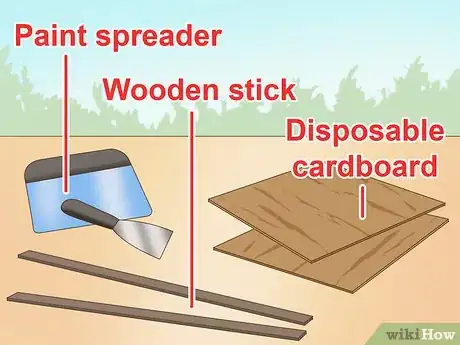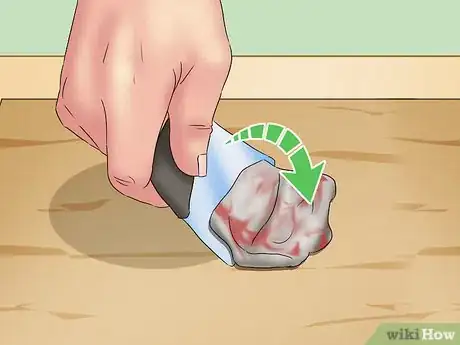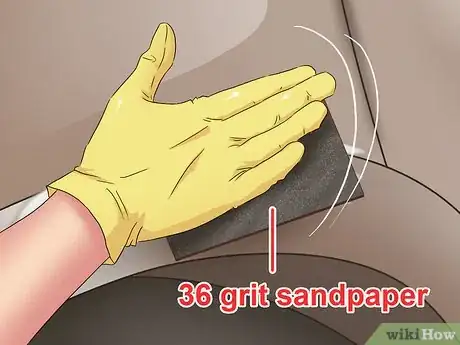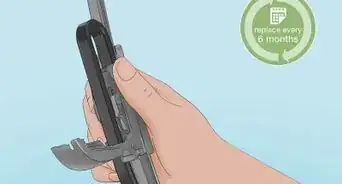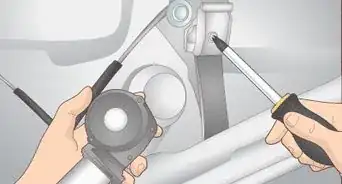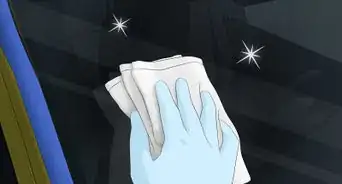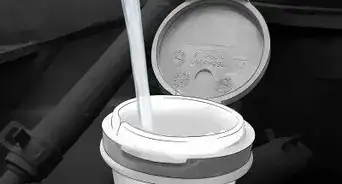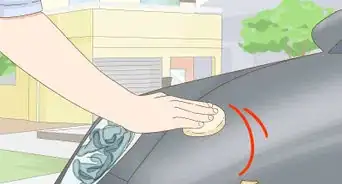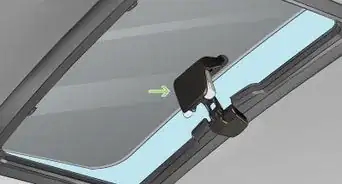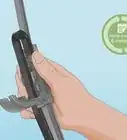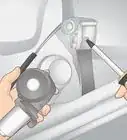This article was co-authored by wikiHow Staff. Our trained team of editors and researchers validate articles for accuracy and comprehensiveness. wikiHow's Content Management Team carefully monitors the work from our editorial staff to ensure that each article is backed by trusted research and meets our high quality standards.
There are 8 references cited in this article, which can be found at the bottom of the page.
This article has been viewed 137,120 times.
Learn more...
Bondo is an automotive body filler, often used for car and household repairs. You can use Bondo to fill in small dings and smooth out warped panels in a car body. Before you begin applying Bondo, make sure to sand down the paint, replace any rusted metal, and mask off any areas that don’t need filler. After that, you’re ready to apply the bondo and fix any small scratches and dings!
Steps
Mixing and Applying Bondo
-
1Find a flat surface and a disposable tool for mixing. Disposable options such as a sheet of cardboard make for an easier clean-up, but you can also purchase reusable plastic sheets. For a mixing tool, use a clean plastic spreader or something disposable, like a popsicle stick.[1]
- It’s best not to use screwdrivers or dirty tools for mixing because they are much harder to clean and could add grease or oil into the mixture.
-
2Mix only as much Bondo and hardener as you can use in 10 minutes. Bondo hardens quickly, so it’s important to mix it in small, usable amounts. Start with a golf-ball sized amount of filler and mix up more as needed.[2] The ratio is also crucial—too much hardener will cause the mixture to gel too quickly, and too little may keep the mixture from hardening at all.[3]
- Finding the right ratio takes experience, but you can get close by estimating that each inch of raw filler diameter requires an inch-length of hardener.
- For example, if you use an amount of Bondo with a 3 inches (7.6 cm) diameter, you would mix it with a 3 inches (7.6 cm) line of hardener.
- If you’re struggling with finding the right ratio, look at the product instructions or ask a professional for assistance.[4]
Advertisement -
3Fold together the Bondo and hardener. Use the spreader or popsicle stick to scrape and press the two ingredients together until they’re combined and you can’t see any streaks. This will help prevent air bubbles from forming.[5]
- Make sure to apply the mixture within 3 minutes of combining. If you wait longer, the mixture will turn into a gel and won’t stick to anything.
-
4Use a plastic or metal spreader to apply thin coats of filler. Load up your spreader with some Bondo mixture and scrape an 1⁄8 inch (0.32 cm) layer over the damaged area. Press down with the spreader to push the filler into the metal.[6] Keep applying thin coats until all the dings are filled, up to a total thickness of 1⁄4 inch (0.64 cm).
- Never use Bondo for any imperfections deeper than 1⁄4 inch (0.64 cm). Using the product on a ding deeper than 1⁄4 inch (0.64 cm) will likely not adhere or hold up well, and the Bondo will eventually shrink and either crack or fall off.[7]
- If you applied masking tape beforehand, let the filler sit for several minutes before gently removing the tape.[8]
-
5Wait 3-10 minutes for the Bondo to fully cure. Since you’ll be sanding and applying pressure after it dries, make sure the filler has time to fully harden and cure.[9]
Sanding and Finishing
-
1Level the filler with 36-grit sandpaper. Start sanding with a heavier grit to even out the dried filler quickly. Sand in alternating directions until the filler-covered section is level and smooth.[10]
- To avoid scratching the surrounding area, keep the sandpaper on the filler only and don’t let it slide onto the painted surface.
- Sanding in straight lines creates waves in the filler, so always sand in a criss-cross pattern.
-
2Remove any scratches with 80-grit sandpaper. The finer 80-grit will help smooth out any scuffing from the 36-grit sandpaper. You can start to feather out the edges of the filler and sand out onto the paint for a seamless effect. Keep sanding until all of the 36-grit scratches are sanded out.[11]
- This can be a long and tedious process, but all of your sanding will soon pay off with a smooth, even application!
-
3Prime and paint the area to blend it in with the rest of the car. Once the filler is sanded down smooth, you can paint over it. Let the paint cure, and the body of your car will look as good as new.
Community Q&A
-
QuestionMy Bondo is lumpy. Should it be smooth?
 Community AnswerYes, it should not be lumpy at all, Get new Bondo and new hardener, mix some up, and you will see how it is supposed to be. Close the lid tight to prevent it from getting lumpy.
Community AnswerYes, it should not be lumpy at all, Get new Bondo and new hardener, mix some up, and you will see how it is supposed to be. Close the lid tight to prevent it from getting lumpy. -
QuestionShould I use Bondo to repair a half inch deep by half inch diameter hole in a wooden cabinet?
 MR KYLE WCommunity AnswerNo, Bondo is not the best for hole repair for anything made out of wood. Bondo is designed to be used for automotive body repair applications. Wood filler is the best choice to fill hood holes.
MR KYLE WCommunity AnswerNo, Bondo is not the best for hole repair for anything made out of wood. Bondo is designed to be used for automotive body repair applications. Wood filler is the best choice to fill hood holes.
Warnings
- Protect yourself from inhaling dust or harmful fumes by using protective gear (such as a mask, respirator, and gloves) and working in a well-ventilated area.⧼thumbs_response⧽
Things You’ll Need
- Bondo filler
- Hardener
- Sheet of cardboard or plastic
- Metal or plastic spreader
- Popsicle stick
- Sandpaper
- Painter's tape
- Protective gear
- Primer and paint
References
- ↑ http://www.secondchancegarage.com/public/242.cfm
- ↑ http://www.secondchancegarage.com/public/242.cfm
- ↑ http://www.hotrod.com/articles/0802sr-using-bondo/
- ↑ http://www.hotrod.com/articles/hrdp-0805-how-to-use-body-filler/
- ↑ http://www.secondchancegarage.com/public/242.cfm
- ↑ https://youtu.be/fRPEDZ7Q3vM?t=193
- ↑ http://www.secondchancegarage.com/public/555.cfm
- ↑ https://youtu.be/fRPEDZ7Q3vM?t=193
- ↑ https://makezine.com/projects/make-40/working-with-bondo/
About This Article
To apply Bondo, mix an inch diameter of the filler per inch-line of hardener. For example, use a 3-inch diameter amount of Bondo for a 3-inch line of hardener. Use a spreader or popsicle stick to mix the 2 ingredients together until there are no streaks left. Only mix as much as you can use in 10 minutes, since Bondo hardens quickly and you don’t want to waste it. Once you’ve mixed the Bondo and hardener, apply the mixture in thin coats about 1/8 inch thick and press it down into the cracks. After 10 minutes, use 36-grit sandpaper to smoothen out the surface. If there are any scratches or scuffs from the 36-grit, use 80-grit sandpaper to get rid of them. For more tips, including how to prime and paint a car after applying Bondo, read on!
